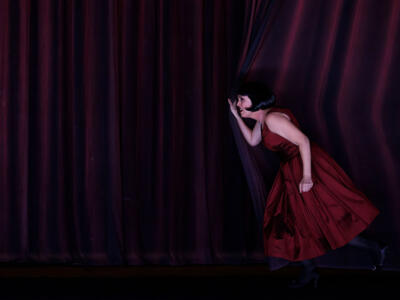La traviata: The Fallen Woman
At a time where a woman’s virtue was a highly prized commodity, the idea of the ‘fallen’ woman filled art and literature, and Verdi’s La traviata was no exception.
In the mid-19th century, to be ‘fallen’ was an umbrella term that was applied to women who had fallen out of God or society’s favour. Art and literature from the time reflect how important upholding societal norms were for women, and how destructive it would be for them should they fall from society.
La traviata: Violetta
Video
La traviata’s heroine Violetta is the archetypal fallen women. A Parisian courtesan suffering with consumption, Violetta tries to leave her fast-paced life behind to be with the romantic Alfredo. In a time were social status was everything among the wealthy, Alfredo’s father convinces Violetta to leave his son before their scandalous relationship gets out.
As with many of these tragedies, redemption from the ‘fallen’ life can only be bought through death. And so, Violetta ultimately dies in her lover’s arms, just as Alfredo discovers the truth about his father’s plot.
Violetta is not the only woman condemned to death in Verdi’s operas. Rigoletto‘s daughter Gilda sacrifices herself to save the man she loves. Aida is buried alive with her lover. These women may not have been the archetypal ‘fallen women’, but they pay the ultimate price for the men they love.
A Streetcar Named Desire: Blanche
Video
From the offset, we learn that Blanche DuBois has fallen from society. She has lost her wealth, is losing her looks and is battling issues with alcohol and her mental health. Her misfortunes, which have led to her down fall, and promiscuity, have made her something of a social pariah.
As with almost all works around the fallen woman, Tennessee Williams’ A Streetcar Named Desire ends in tragedy. Blanche is attacked and then admitted to an asylum by her brother-in-law Stanley.
An important aspect of the depiction of the fallen woman, is the obvious disparity between the way men and woman are treated by society. In this instance, Stanley, a violent man who shows no remorse for his horrendous actions, continues to live a normal ‘happy’ life, while Blanche is shunned from society and meets a gloomy end.
Oliver Twist: Nancy
Video
Although Nancy’s profession is only hinted at, it is made clear that Nancy is a fallen woman. Unlike many writers of the time, author Charles Dickens wants the reader to know she is still a good person, and so circumstance can be blamed for her fall.
It is a little known fact that Dickens spent much of his time trying to help destitute women in Victorian England. For 12 years, he managed the Home for Homeless women at Urania Cottage, helping to rehabilitate women at a time where the English believed a ‘corrupted’ woman could never be uncorrupted. It’s this compassion for London’s fallen women that paints Nancy as a victim as exploitation, and as someone with a moral conscience.
Nancy ultimately dies at the hands of the man who can be blamed for her downfall. A man she loved, and chose to stay with, even when she was offered a new life free from sin and sorrow.
Les Miserables: Fantine
Video
Like Charles Dickens, Les Misérables author Victor Hugo portrayed his fallen woman as someone who society has failed. Fantine, a woman who has found herself pregnant and alone, sacrifices her own dignity to provide for her daughter. Fantine may be a fallen woman in society’s eyes, but she is morally good and will do anything she can to provide for her daughter.
Hugo was actually inspired to create Fantine after an incident he witnessed in Paris: a man had attacked a woman working on the streets, and when the police turned up it was the woman who faced being arrested. The injustice women of the time faced was noted by Hugo, and reflected in the way kind-hearted Fantine met her demise.
The Scarlet Letter: Hester Prynne
Video
Nathaniel Hawthorne‘s The Scarlet Letter is a perfect example of the hypocrisy between the sexuality between men and woman. At the time the book was set, in puritan America, it was far worse for a woman to commit an adulterous act than a man. The book’s fallen woman Hester is publicly humiliated for being pregnant by a man she has had an affair with.
In both literature and real life, becoming pregnant with a man you weren’t married to, at this time, was the ultimate act of shame. Women who found themselves in this position were almost always ostracised from friends and family, and in many cases women had no choice but to give up their child.
Because of the proof of Hester’s ‘sexual misdemeanour’ (her pregnancy), she is forced to wear a scarlet ‘A’ for the rest of her life, so everyone would always know she was an adulterer.
Anna Karenina: Anna
Video
Leo Tolstoy‘s Anna Karenina is often one of the first fallen women to come to mind when thinking of their portrayal in literature.
Like Hester Prynne, Anna is chastised for having an affair and shunned from society. The heroine herself becomes increasing jealous that her lover Vronsky is able to live a relatively normal life once their affair has gone public, while Anna remains housebound and scorned. These feelings of resentment drive Anna to become increasingly neurotic, which lead to her believing death is the only way to escape her fallen life.
Similarly to The Scarlet Letter, the heroine in this book is the only person punished for being unfaithful, whilst the men face little repercussion.


